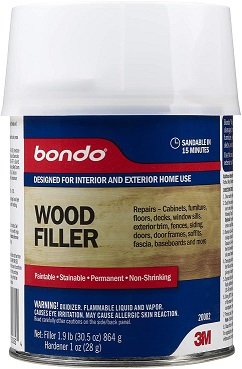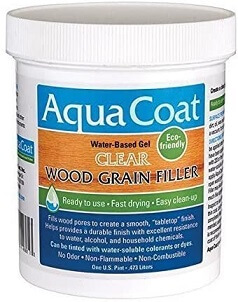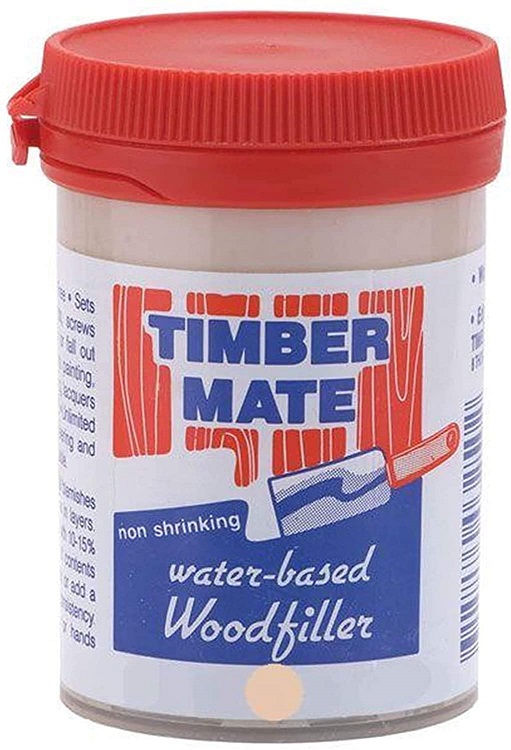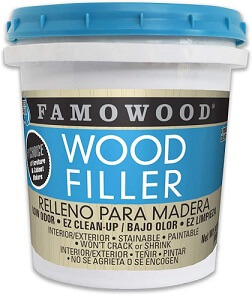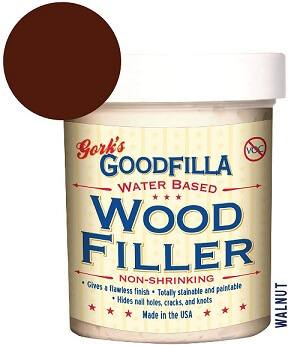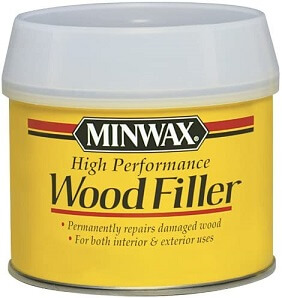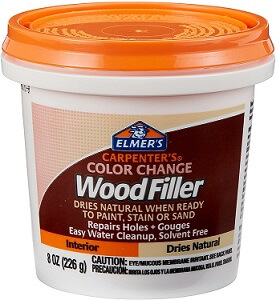Wood fillers are crucial for fixing cracks, holes, and imperfections in wood during woodworking and DIY projects. They are available in different types, like water-based, epoxy, and polyurethane, tailored for various wood types and uses. These fillers can be modified by sanding, staining, or painting, ensuring smooth repairs and restorations.
Key considerations for purchasing the best wood fillers:
- Type: Our analysis includes water-based and solvent-based fillers. Water-based fillers are easy to use and dry quickly, perfect for indoor projects. They are also simpler to clean and more eco-friendly. Solvent-based fillers, however, provide enhanced durability and are preferable for outdoor projects where resistance to weather is essential.
- Interior vs. Exterior Use: Whether a filler is meant for interior or exterior use greatly influences our recommendations. Fillers for interior use are designed for environments with less exposure to moisture and UV light, focusing on ease of sanding and painting. Exterior fillers are made to endure tough weather conditions, ensuring repairs last.
- Drying Time: The drying time affects how quickly a project can move forward. Some fillers dry in just 15-30mins, perfect for quick tasks, while others need more time to cure i.e. 2hrs or more, potentially delaying the project. Our selection covers a range of drying times to meet different project needs.
For a more detailed understanding of wood fillers and guidance on choosing the best option, please refer to our “Buying Guide” section. Additionally, you can review our top picks for wood fillers to make a well-informed choice.
7 Best Wood Fillers: Table
| Wood Filler | Type | Container Size Available | Buy Now |
|---|---|---|---|
| Bondo Wood Filler | Solvent Based | 1 Quart | Check On Amazon |
| Aqua Coat Wood Grain Filler | Water Based | 8 Ounces | Check On Amazon |
| DAP 00585 Latex Wood Filler | Water Based | 1 Pint | Check On Amazon |
| Famowood Wood Filler | Water Based | 8 Ounces | Check On Amazon |
| GoodfIlla Wood Filler | Epoxy Solvent Based | 12 Ounces | Check On Amazon |
| Minwax Wood Filler | Water Based | 8 Ounces | Check On Amazon |
| Elmer's Wood Filler | Water Based | 1 Pint (or 1 Quart available too) | Check On Amazon |
7 Best Wood Fillers Reviews
1. Bondo Wood Filler
The Bondo 200082 Home Solutions Wood Filler stands out as a top-rated, best-selling product for wood repairs. This 1-quart package contains premium wood filler ideal for fixing small cracks in doors, windows, furniture, and shutters. It’s user-friendly, making it perfect for DIY enthusiasts, hobbyists, and even beginners. You can shape, sand, or drill into the filler after it dries, which begins within 15 minutes of application, so quick action is required. Once dry, it effectively mimics hardwood, offering a durable and seamless repair solution.
Things we liked about It:
- Comes in a large 1-quart container capacity thus is great for the long term through storage too.
- Beginner-friendly
- Has a multi-purpose use
- Easily shaped and drilled, sanded or even planed too once dry.
- Dries up very fast in just 15 minutes thus you need to be very fast in using it
Things we didn’t like about It:
- Highly thick in nature thus once you are done with half bottle, the last 10% will be difficult to use.
2. Aqua Coat Wood Grain Filler
Aqua Coat is a water-based, low-odor wood grain filler that is environmentally friendly and highly rated. Suitable for everyone from DIYers to professional contractors, it efficiently fills wood grain, seals pores, and enhances finishes on various surfaces including tabletops, cabinets, and musical instruments. It’s also applicable on plastic. Being waterborne, it features low VOC, minimal odor, and quick drying time. The filler is safe, non-flammable, and can be mixed with water-soluble dyes for consistent coloring. It dries in 45 minutes to an hour and can be sanded for a smooth finish. For optimal results, apply 2 or 3 coats. One quart can cover up to 40 drawers, making it cost-effective for large projects.
Things we liked about It:
- Water Soluble natural wood grain filler
- Low VOC
- No odour
- Easily mixable
- Eco-Friendly
- Can be printed, painted and more
- Gives you a great and smooth finish
Things we didn’t like about It:
- Can’t be heavily sanded
- Takes longer to dry
3. DAP 00585 Latex Wood Filler
DAP is renowned for its high-quality adhesives, and their solvent-based wood filler is designed to offer a repair strength three times that of wood. This professional-grade filler is durable, incorporating real wood fibers for a natural look and feel. Once fully dried, it can be treated like wood, allowing for screwing, staining, varnishing, sanding, or painting. It provides secure nail and screw anchoring without splitting. The filler sets quickly, resists shrinking and cracking, and is user-friendly with a mild odor.
Things we liked about It:
- Latex based formula
- Contains real wood fibers
- Looks and acts like real wood
- Easy to use
- Low odor
- Cleans up with water
- Dries up fast
- Shrink and crack resistant
Things we didn’t like It:
- Gives off greyish color after drying up
4. Famowood Wood Filler
The FamoWood 40022126 Latex Wood Filler is a highly-rated, versatile product suitable for both indoor and outdoor use on any wood type, without worries about clean-up. It efficiently fills both large and small gaps, ensuring the repaired areas do not shrink or crack. This solvent-free filler is easy to clean with water and is odorless, making it comfortable to use. Its unique coloration blends seamlessly with wood, offering a natural finish. Ideal for addressing various wood imperfections, this filler provides a reliable solution for enhancing the durability and appearance of wood surfaces.
Things we liked about It:
- High-quality putty for a great value of money
- Solvent-free make
- Does not shrink or crack at the end
- Quick-dry in 15 Minutes
Things we didn’t like about It:
- A bit pricey
5. GoodfIlla Wood Filler
The Goodfilla wood filler, in a walnut shade, comes highly recommended for its quality and includes a warranty or money-back guarantee. Designed for professionals, it is ideal for extensive repairs and patching. This water-based filler dries quickly but can be easily removed with water if needed. While it absorbs water, which may not be suitable for outdoor use due to humidity, it withstands temperature variations well, making it perfect for indoor projects. Its strong adhesive properties can even support a large screw without shifting. The company offers a one-year money-back guarantee, underscoring their confidence in the product’s performance.
Things we liked about It:
- Water-based solvent-free grain
- Easily applicable and easy to remove as well.
- Great hold that it can even hold up a screw or a nail
- Has a 365 days (1 year) money-back guarantee as well
Things we didn’t like about It:
- Can’t hold up against humidity thus is only good for indoor projects
6. Minwax Wood Filler
The Minwax 21600000 is a high-performance epoxy wood filler, known for its remarkable strength and ability to securely hold screws and nails once dry. This makes it suitable for both indoor and outdoor use, thanks to its water-resistant properties. It’s available in various colors, eliminating the need for painting in many cases. The filler dries quickly, similar to epoxy glue, and comes with a hardener for mixing, although it may be somewhat thick. It can be applied to wood, metal, plastic, ceramics, fiberglass, and more, setting in 15 minutes and ready for sanding in 30 minutes.
Things we liked about It:
- Available in many shades and colours to choose from
- Quick to dry
- No cracks or shrink issues
- The very hard setting thus can be used to hold together screws and nails too
- Can bond with almost anything
Things we didn’t like about It:
- Though quick in drying, it does not leave a lot of time window after mixing it
- 2 Part mixing can be a bit cumbersome
- A bit expensive in nature
7. Elmer’s Wood Filler
Elmer’s E913 Carpenter’s Wood Filler is a color-changing filler, available in 8 or 16-ounce sizes, perfect for indoor repairs like furniture dents, chair fixes, or wallboard. Its unique formula changes from purple to white as it dries, indicating readiness. It dries quickly, in about 15 minutes for small repairs, but larger fixes may need 2 to 8 hours. Once dry, it can be sanded, painted, or stained. Ideal for light, indoor use, this filler efficiently fills voids and covers holes, providing a versatile solution for home repairs.
Things we liked about It:
- Beginner friendly and can be easily used by anyone.
- Available in 8 ounces, 4 ounces and 16-ounce tubs
- Stainable, printable, paintable and sandable post drying.
- Patented non-toxic formula
- Naturally dries quickly in just 15 minutes
- Changes colour from purple to white (when fresh to completely dried)
Things we didn’t like about It:
- The putty make require a longer time to dry out when used for deep voids or large dents
- A tad bit expensive pricetag
Buying Guide: How To Choose a Good Quality Wood Filler?
When selecting the best wood filler for your project, understanding the various factors that influence your choice is crucial. Here are the key considerations to keep in mind:
1. Type
Understanding the differences between water-based and solvent-based wood fillers is crucial for selecting the right product for your project. Each type has its own set of characteristics that make it more suitable for specific applications.
a. Water-Based Wood Fillers
Why it Matters: Water-based wood fillers are environmentally friendly, emitting fewer volatile organic compounds (VOCs), which translates to a less potent odor. Their ability to dilute with water makes them highly versatile for projects requiring either a thick or thin consistency. This adaptability is particularly useful for interior projects where the filler’s appearance and ease of manipulation are critical.
What to Look For: When selecting a water-based wood filler, consider the project’s location (it should primarily be for indoor use due to its water sensitivity) and the desired finish (whether you need to paint or stain over the filler). Look for fillers that offer quick drying times if you’re on a tight schedule and prefer products that can be easily cleaned up with soap and water.
b. Solvent-Based Wood Fillers
Why it Matters: Solvent-based fillers are distinguished by their robustness and resistance to environmental factors such as humidity, water, rot, and temperature extremes. Their composition, typically containing epoxy or vinyl, ensures a stronger bond, making them ideal for exterior projects where durability is paramount. Despite their higher VOC content and the associated stronger odor, their resilience makes them a go-to for repairs exposed to the elements.
What to Look For: When considering a solvent-based wood filler, prioritize products known for their durability and resistance to outdoor conditions. The longer drying time (about an hour) means planning is essential, so factor this into your project timeline. Additionally, the need for solvents like turpentine or acetone for cleanup should be considered, especially if you’re looking for ease of use and minimal environmental impact. Despite their higher cost compared to water-based options, their longevity in harsh conditions often justifies the investment.
2. Interior Vs. Exterior
The distinction between interior and exterior applications is a critical factor in selecting the right wood filler.
Why it Matters: Interior and exterior wood fillers are formulated differently to cope with the environments they’re exposed to. Interior fillers are designed to be easier to sand and finish, as they won’t face the harsh conditions of the outdoors. Exterior fillers, however, are made to withstand elements like moisture, temperature changes, and UV exposure, ensuring repairs last over time.
What to Look For: For interior projects, look for fillers that are easy to apply, sand, and can be painted or stained to match your woodwork. For exterior projects, prioritize fillers that are specifically labeled for outdoor use, offering waterproof or weather-resistant properties to ensure the longevity of your repairs.
3. Color
Why it Matters: The color of the wood filler is crucial for ensuring that your repair blends seamlessly with the surrounding wood. A mismatched color can make the repair stand out, detracting from the aesthetic of the piece.
What to Look For: Look for a wood filler that closely matches the color of the wood you are repairing. Many brands offer a range of colors, and some can even be mixed to achieve the perfect match. If you plan to paint or stain the wood after the repair, consider a stainable or paintable wood filler to ensure a uniform finish.
4. Drying Time
Why it Matters: The drying time of wood filler impacts the overall project timeline and the flexibility you have in working with the material. Fast-drying fillers are excellent for quick repairs when you’re short on time or need to complete a project rapidly. They allow for sanding, painting, or staining to occur sooner, thus speeding up the completion of your work. On the other hand, fillers with longer drying times provide more leeway for adjustments. This can be crucial for intricate repairs or when working with complex shapes, as it gives you the opportunity to smooth out or reshape the filler as needed before it sets.
What to Look For:
- For Quick Projects: If your primary concern is speed, look for latex, water-based, or cellulose wood fillers that advertise quick drying times, typically setting in 15 to 30 minutes. These fillers are ideal for straightforward repairs where the aesthetic finish is not overly complex, and the work needs to be completed in a short period.
- For Detailed Work: When precision and the ability to make adjustments are key, opt for fillers that offer a longer working time, such as epoxy fillers. Though some may take 30 to 40 minutes to dry, others might require up to 2 hours before they’re fully set. This extended drying time is beneficial for detailed or large-scale repairs, allowing ample time to perfect the filler’s application and ensure it matches the surrounding area.
5. Quantity
Why it Matters: The amount of wood filler needed depends on the size and number of repairs. Purchasing too little can halt your project mid-repair, while too much could be a waste of resources.
What to Look For: Estimate the volume of filler you’ll need based on the depth and width of the voids you’re filling. Wood filler is often available in various sizes, from small tubes to larger cans. For larger projects or frequent use, buying in bulk may be more economical. Conversely, for a single, small repair, a smaller quantity will suffice.
6. Paste Vs. Powder
Why it Matters: Wood fillers come in two primary forms: paste and powder. Paste fillers are ready to use and offer convenience, while powder fillers must be mixed with water or another solvent before application, allowing for custom consistency.
What to Look For: If convenience and ease of use are your priorities, a paste filler is the best choice. These are typically easier for quick, small repairs. Powder fillers, on the other hand, offer more flexibility in adjusting the filler’s density to suit the repair’s needs. Consider a powder if you’re dealing with a range of repair sizes or require a specific consistency for the task at hand.
Types of Wood Fillers
Wood fillers are available in several types, each with its own set of characteristics. Here’s a brief overview of the most common types:
- Cellulose-Based Wood Filler: Comprising wood fibers and binders, this filler comes in a dry, mixable paste form. It’s quick to dry, emits low odor, and resists shrinking, making it suitable for both outdoor and indoor use. However, it may require staining during application.
- Gypsum-Based Wood Filler: Made from mineral powders, this filler offers excellent bonding strength but must be mixed with water to achieve the right consistency. Its primary limitation is that it’s not weatherproof, restricting its use to indoor projects. The drying time can vary based on the mix’s consistency and the size of the area being filled.
- Latex Wood Filler: A favorite among professionals and DIY enthusiasts alike, latex filler sets quickly (about 15 minutes) and works well for both indoor and outdoor applications. It can mimic real wood and is used to repair various defects in wood surfaces including furniture, doors, and moldings.
- Epoxy Wood Fillers: Known for its strong adhesion, epoxy filler can fill in missing chunks of wood effectively and can be painted, stained, or drilled into. While it provides a durable repair, its appearance is somewhat plastic-like, setting it apart from other fillers.
- Vinyl Wood Filler: Ideal for beginners due to its soft, flexible, and easy application, vinyl filler works well for filling in cracks and holes. However, it’s prone to cracking if applied too thickly, making it less favorable for some users. Despite this, its resistance to water and UV rays makes it a good choice for exterior wood applications, although it’s often recommended to paint over it to ensure durability.
Each type of wood filler has its specific uses and benefits, so choosing the right one depends on the requirements of your project, including the location of the repair (indoor vs. outdoor), the desired finish, and the application’s ease.
Wood Putty Vs. Wood Filler
If you’re new to wood repair, you might find yourself mixing up wood filler with wood putty, or even using one when the other might be more appropriate. Here’s a brief overview to help you understand the differences and applications of each.
1. Wood Putty
Wood putty is made from calcium carbonate and oil, making it suitable only for use with oil-based finishes. It’s not as versatile as wood filler and takes longer to dry. However, its excellent resistance to weather makes it ideal for outdoor use. Wood putty is also cost-effective, which is why it’s a good choice for large projects like wooden flooring, where it offers durability at a lower cost than wood fillers.
2. Wood Fillers
Wood filler is effective for addressing various wood imperfections, including blemishes, scratches, rot, gouges, or holes. It spreads easily across wooden surfaces and sets quickly, making it convenient for quick repairs. Wood filler’s fast drying and curing time, along with its versatility, make it a preferred option for repairing and smoothing out wood flaws.
How to Use Wood Filler?
Using wood filler is a straightforward process, though it does involve several steps to ensure a successful application. Before you begin, make sure you have all necessary materials on hand, including solvents, a putty knife, the wood filler itself, and a spatula for mixing.
Here’s a step-by-step guide to applying wood filler effectively:
- Prepare the Surface: Start by sanding the wood surface thoroughly. This creates a rough texture for the filler to adhere to, ensuring a strong bond.
- Mix the Filler: Next, prepare your chosen wood filler. Use a spatula to mix the filler with the appropriate solvent until you reach a suitable consistency. Aim for a mixture that is malleable but not too thick or too thin. A thick mixture might not fill the cracks well and could crack, while a too-thin mixture might not dry properly.
- Application: Apply the filler to the wood surface using a putty knife. Spread it evenly, filling all cracks or holes without applying pressure. The filler should naturally settle into the imperfections.
- Drying Time: Allow the filler to dry completely. The drying time can vary, so it’s important not to rush this step.
- Finishing Touches: Once dry, remove any excess filler and sand the area smooth. This prepares the surface for painting or staining, if desired.
Pro Tip: For optimal results, allow the filler to dry thoroughly, ideally for 24 hours, before proceeding with any further finishing. This ensures the filler bonds well with the wood and reduces the risk of cracking or breaking.
Wood Fillers: Uses and Advantages
Wood fillers serve a variety of purposes, each offering distinct benefits for maintaining and repairing wood surfaces. Here’s an overview of how they can be applied to enhance and protect your wood items.
- Cleaning: Outdoor wood surfaces often collect dirt and grime. Water-based fillers can be an effective solution for cleaning these surfaces without harming their finish or texture.
- Smoothing Surfaces: A thin layer of filler can help smooth out rough textures and coarse grains in wood. After the filler has set, a bit of polishing can significantly improve the wood’s appearance. This technique is commonly used in regular maintenance to keep furniture looking its best.
- Concealing Scratches: For those with pets, wood fillers are incredibly useful for covering up bite or claw marks on furniture. A simple application of filler can make these blemishes virtually disappear.
- Filling Holes: For deeper holes, a 2-part epoxy filler is recommended. This type of filler bonds well with the wood, creating a uniform appearance that, after sanding or staining, looks as good as new.
- Repairing Rotten Wood: Plastic wood fillers are particularly effective for dealing with rotten areas. They not only fill in the damaged spots but also provide enough support to hold screws, restoring the wood’s functionality and appearance.
Wood Fillers – FAQs
Ans: Yes, it is used to repair scratches, especially for not too deep scratches. For this, you apply a liberal amount of filler on the scratch and remove the excess. Then sand it to clear lumps and to get an even smooth finish. You need a small can or tube of wood filler for this purpose.
Ans: It depends on the type of wood filler you choose, as some can and some can’t. Solvent-based wood fillers are ideal to cover up any imperfections. It lacks the structural strength to resist impact. While other fillers may mimic with the wood’s structural strength and used to treat on any plain wooden surface. So, those are the best fillers that let you use filers for large holes to be drilled and shaped.
Ans: Choose a solution with having a stainable label, which let you stain the wooden surface to your preferred shade. Also, there are various products available in a wide range of colors that perfectly fit each type or color of the wood. One can easily find fillers in shades like white, dark oak, mahogany, pine, etc.
Ans: It mostly depends on the type of fill. Applying the filler in thin layers and leave it for some time before every application will dry out quickly. Applying a filler in a small container will quickly dry out and sanded after 30 minutes of its drying time. While for deeper fills, leave it to cure for about 2 – 3 hours before sanding to get a smooth even finish.
Ans: The wood fillers will dry out in their storage containers after months (if left unused), which makes a waste of money spent on it. So, we suggest you purchase the filler depend on your required quantity for your project/purpose.
Looking to stop the wood filler from drying out, then add a little water to this solution inside the container or tube to replenish the solution. Or flip the container upside down after using it.
Ans: Yes, you can use wood fillers outside. Some fillers designed specially to use outdoors, as they are weather-resistant fillers. But you can use them outdoor and indoor as well. All those exterior wood fillers are waterproof.
Ans: Filling holes in your exterior wood is simple. If filler won’t come pre-mixed, then mix it well and apply the filler inside the hole under the recommended temperature. Make sure to use a putty knife for proper application.
Ans: Yes, we can use wood fillers widely in treating rotten woods.
Ans: The simple answer for this is, you can use a wood putty instead of a wood filler, as both have almost the same benefits and applications.
Conclusion
Selecting the ideal wood filler depends on your specific project needs. Here are three top picks with their strengths:
- DAP Plastic Wood All Purpose Latex Wood Filler: This versatile, water-based option excels for indoor repairs on furniture, trim, and floors. It dries quickly, is easy to use, and takes both paint and stain well.
- Minwax 21600000 High-Performance Wood Filler: This solvent-based formula offers superior strength and adhesion, making it ideal for filling larger cracks, gouges, and even outdoor projects. However, it requires good ventilation due to its stronger odor.
- Aqua Coat Water Based Wood Grain Filler Gel: This eco-friendly, water-based gel is perfect for filling fine grain and pores, especially on light-colored wood. It dries quickly, is odorless, and sands smoothly for a flawless finish.
Remember, consider your project’s specific needs (material, application, drying time, etc.) for the best choice.

